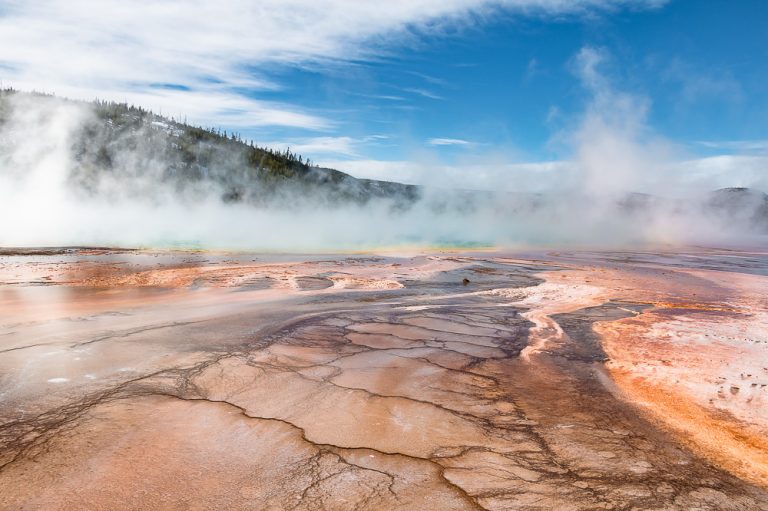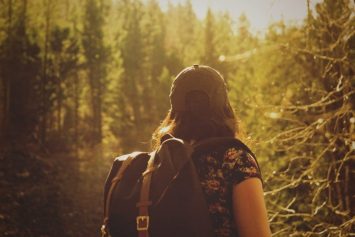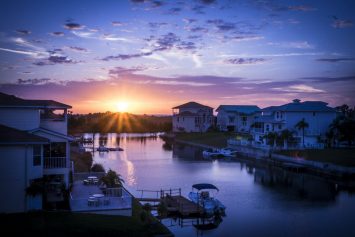Set in a remote area of northwestern Wyoming, Yellowstone National Park is the ultimate travel destination for a weekend in the great outdoors. Known as the oldest national park in the USA, the place encompasses some of the most unusual natural wonders. Abundant wildlife and rare but always welcoming swimming areas further allure and keep weekend visitors coming back for more.

But if you picture yourself running freely in a park, exploring its ample hiking trails, Yellowstone has a surprise for you. Famous for hydrothermal activity underneath its surface, the place is set atop a supervolcano. A myriad of geysers, hot springs, mudpots, fumaroles, and travertines attest to the enormous force underneath the thin layer of earth. Thus, the place might be unpredictable and quite dangerous if you don’t follow park’s rules. Nevertheless, it never ceases to impress and inspire. Nearly four million visitors flock to this remote area in the American West yearly to admire its hydrothermal natural wonders in person.
Quick Navigation
ToggleHow to Get to Yellowstone
Yellowstone National Park occupies one of the most isolated areas in the USA, making a weekend visit challenging, but not impossible. The place is located mostly within Wyoming although its northern and western parts spread into Montana and Idaho. Five entrances let the visitors enter the park from north, northeast, south, east, and west. The West Entrance is by far the most popular, alluring weekend roadtrippers from Utah and Idaho.
The protected area is home to a wide range of wild animals that thrive in this remote region. At the same time, the isolated location presents some difficulties for its human visitors, especially those who travel from overseas. The closest international airports sit hours away from Yellowstone National Park. On the other hand, the number of destinations to fly into before renting a car and driving to Yellowstone National Park is rather broad. Here’s the list of international airports closest to the park:
- Salt Lake City International Airport. Salt Lake City, Utah, is one of the most popular destinations to start a weekend adventure in Yellowstone. The city is located approximately 4 hours 45 minutes from West Yellowstone.
- Bozeman Yellowstone International Airport. The airport near Bozeman, Montana, is set 1 hour 30 minutes from North Yellowstone with its Mammoth Hot Springs Terraces and alluring valleys.
- Boise Airport. Boise, Idaho, is the least popular city to fly into. The city nestles approximately 5 hours 40 minutes away from West Yellowstone. It’s quite a long drive. However, usually lower airfares at the Boise Airport and plenty of incredible destinations along the way suit the majority of budget travelers.
Several regional airports near Yellowstone National Park decrease the amount of time you spend in a car and let you enter the park much quicker. Jackson Hole Airport in Grand Teton National Park is the closest airline service. After flying into it, you can start exploring the natural wonders of Yellowstone in a little bit over an hour.
Year-round commercial airline services are also available into Jackson, WY, and Cody, WY. Although, they come with a hefty price on top of $35 Yellowstone entrance fee.

The Best Time to Travel to Yellowstone National Park
Unlike the majority of other national parks in the USA, Yellowstone is a seasonal attraction. The best time to travel to this remote area is from May through September. On the flip side, it’s the busiest time of the year when narrow boardwalks across the park see endless crowds of amused visitors.
Weekend visits to Yellowstone National Park feel less chaotic during the shoulder months. Normally, it’s April until mid-May and late September though October. Weather is not ideal, and gusty winds don’t feel inviting at this time. However, you share the Yellowstone’s landmarks with significantly fewer people. Some roads in the park may still or already be closed, though. So, check out the park’s website for the road closures before setting off on the adventure.
Yellowstone National Park is closed for private vehicles in winter. Only snowmobile and slowcoaches can enter the park. Most of the roads are closed due to heavy snowfall and harsh winter conditional reigning in the park at this time.

Visit Yellowstone on Weekends
A weekend trip to Yellowstone might be a little bit overwhelming especially in high season. You inevitably share the area with endless crowds arriving in private vehicle or tour busses. Therefore, plan your adventure ahead of time and aim to visit the most popular places early in the morning or late in the afternoon. On top of that, you might want to spend more than two days exploring the famous and lesser-known natural wonders of Yellowstone. However, if you have just a weekend, make the most of it.
Tip: You can also add a self-guided photography tour in Grand Teton National Park to your weekend visit to Yellowstone National Park. The parks sit next to each other and show different sides of Wyoming. The South Yellowstone Entrance lets you tick off both of these national parks in one visit.
What to Do in Yellowstone on a Weekend
Day 1: Geysers and Hot Springs
Old Faithful and Upper Geyser Basin
Start your day early and hit the most popular destinations before tour buses flock to the areas. As Old Faithful entices most of the visitors of the park regardless of the season, you should plan to see it first.
Located in the Upper Geyser Basin, the famous geyser is one of five big hydrothermal features which eruptions can be predicted. Old Faithful erupts on average every 65 to 95 minutes, shooting a column of boiling water up to 180 feet into the air.
While the famous geyser is certainly worth attention, don’t sit idly waiting for the next eruption. Instead, walk along the boardwalks and explore other geysers and hot springs of the basin. And there is plenty of things to see in the place with the largest single concentration of the hydrothermal features in the world.
Some of the most popular attractions in the basin are Castle Geyser, Beehive Geyser, and Morning Glory Pool. The latter nestles at the end of the trail that starts near the Old Faithful Inn. The remote areas of the Upper Geyser Basin are not busy. Usually only a small number of the tourists that stare in awe at Old Faithful hike here.
Biscuit Basin Loop
From the Old Faithful Geyser, continue hiking to the Biscuit Basin Loop, nestled approximately 3 miles away. To save time, you can also drive here. Small parking lot is located in front of a 0.5-mile boardwalk trail. The path circles around the basin, showcasing colorful hot springs and hissing geysers such as Sapphire Pool, Back Opal Pool, and Shell Spring. The basin never gets as busy as the Old Faithful area and might be exactly what you need if you are not able to beat the crowds early in the morning.
Grand Prismatic Spring
The Grand Prismatic Spring is another popular destination in Yellowstone National Park. The vibrant hot spring nestles in the Midway Geyser Basin, a short drive from the Old Faithful area. The Grand Prismatic Spring is the largest hot spring in the USA and the third largest in the world. If the vivid colors of Yellowstone made a strong impact on you already, yellow and orange brilliance of this hot spring intensifies this impression tenfold.
Interestingly enough, the natural wonder owes its rainbow colors to heat-loving bacteria, living near the brim. The large number of the microorganisms cluster next to each other, creating the famous colorful “rings”. The temperature at the center of the Grand Prismatic Spring is too hot even for the heat-loving bacteria. Thus, it remains completely unoccupied, impressing with its deep blue shades against the brightly-colored edges.

Norris Geyser Basin
The first day of this weekend trip to Yellowstone is all about the geyser basins. The last stop of the day is not an exception. It also impresses with some of the remarkable hydrothermal features of the park. Less popular than the Upper and Midway Geyser Basins, the Norris Geyser Basin is the oldest and most dynamic area in Yellowstone. It consists of two sections: Porcelain Basin and Back Basin. Both of them present the geysers of all sized and shapes.
The Norris Museum set as a gateway to the basin educates their visitors about history and life in the hydrothermal area. The highlight of the basin, however, is Steamboat Geyser. Hidden in the often overlooked Back Basin, the geyser rises to fame as the tallest active geyser in the world. Its major eruptions shoot jets of water more than 300 feet.

Day 2: Grand Canyon of the Yellowstone River, Mammoth Hot Spring Terraces, and Lamar Valley
Grand Canyon of the Yellowstone River
Surprisingly, the USA has more than one Grand Canyon. While Arizona reserves the right to dazzle the world with the largest abyss and its impressive attractions such as Grand Canyon Skywalk, Wyoming astounds with its smaller, but not less spectacular chasm. The Grand Canyon of the Yellowstone River is located near Canyon Village on the eastern side of the park. The popular attraction had its begging more than a hundred years ago when merciless erosion and the powerful Yellowstone River joined forces to eventually create a roughly 20-mile long canyon.
The place is divided into two sections: the Upper and Lower Falls areas. Upper Falls plunges down from the height of 109 feet. You can feast your eyes on this splendid view from the Upper Falls Trail and the Uncle Tom’s Trail.
More convenient and easier to access, the Lower Falls area, however, is the most popular of the two sections. The area boasts several hiking trails and a handful of panoramic viewpoints. The most famous overlooks include iconic Artistic Point and Inspiration Point.

Mammoth Hot Springs Terraces
Even after a day filled with the extraordinary natural wonders, Yellowstone never stops amusing its oblivious guests. In the northwest corner of the park, the Mammoth Hot Springs Terraces play the biggest entertainer’s role. Uniquely shaped and surprisingly attractive, the structure is an active, living organism (don’t let its rock-like appearance deceive you). The terraces owe their birth to water and any particles that happen to be on its way. The powerful water force rushes through the structure constantly shaping and polishing it.
Similar to the Grand Canyon of the Yellowstone River, the Mammoth Hot Springs Terraces consists of the Upper and Lower Terraces. Boardwalks and staircases in both areas connect the terraces allowing for a closer look and different photo perspectives of the unique structure. The place, however, strives to be impartial and let both hikers and non-hikers admire its natural wonders. The less adventurous visitors of Yellowstone are welcome to roll down car windows and experience the terraces along the 1.5-mile one-way Upper Terrace Drive loop.
Lamar Valley
The chances are you already encountered some of the inhabitants of rich Yellowstone’s wildlife. If for some reasons, the animals didn’t rush to show themselves or you’re itching for more wildlife viewings, head over to Lamar Valley. Home to bison, pronghorn, grizzly and black bear, coyotes, deer, bald eagles, and wolves, it’s a perfect place to watch and photograph the animals in their natural habitat.
The wild “dwellers” are most active at dawn and dusk. Thus, you should plan your visit accordingly to increase your chances of encountering the wildlife of Yellowstone. Furthermore, sitting off the popular tourist route, Lamar Valley ensures solitude and serenity even in the busiest summer months.
Alternately, you can visit Hayden Valley. Although the brimming with the wild animals area is also a feast for the eyes, more tourists flock to this part of Yellowstone.

For more places to add to your weekend itinerary, please check out 10 Things You Must See on Your First Visit to Yellowstone
Where to Stay in Yellowstone National Park
A weekend trip to Yellowstone surely includes at least one night in the area. If you visit the region in the summer season, your accommodation options are as broad as the park itself.
See the map and main pointers below:
- Many visitors prefer to explore the historic Old Faithful Inn behind the Old Faithful Geyser from outside and inside when in Yellowstone. The place is rather pricey but allows you to explore some of the most popular areas of the park within a walking distance.
- In winter, similar experiences await at Old Faithful Snow Lodge, located a short 10-minute walk from the Old Faithful Geyser.
- 12 campgrounds with more than 2,000 sites invite you to explore the “raw” side of Yellowstone.
The campground and the majority of the lodges in Yellowstone close their doors for the public when the season ends. Thus, if you visit the park in shoulder months, look for the accommodation in nearby cities and towns.
- There are plenty of motels, hotels, lodges, and inns a few minutes away from the West Entrance.
- Jackson and Teton Village offer hotels and resorts for all travel budgets near the South Entrance.

Helpful Tips
Don’t walk off the boardwalks. Yellowstone National Park is not a place where you can roam freely. Due to the volcanic activity underneath the surface, the area can be dangerous. Thus, walking off the boardwalks in Yellowstone’s Geyser Basins is not allowed. On top of keeping its visitors safe, the boardwalks preserve the fragile environment from potential damage and destruction.
Leave no trace. This includes any intentional or accidental drops of personal items such as caps or hats in the thermal waters of the hot springs. Any foreign objects can cause the death of the heat-loving bacteria and eventually destroy the unique environment. As far as throwing coins in the hot springs goes, this superstition guarantees one luck – a hefty fine.
No drone photography. Flying drones in Yellowstone is illegal. Failure to comply with the park’s regulations usually results in heavy financial punishment. Yellowstone also reserves the right to ban its guests from future visits.
Bison jam. You read it right. Yellowstone National Park might be exempt from traffic jams, but bison jams when large herds of bison cross the roads are frequent. Such an unusual encounter can put you 2-3 hours behind your schedule.
Find more information and interesting facts about the area in Yellowstone Beyond: 9 Things You didn’t Know about Yellowstone.






